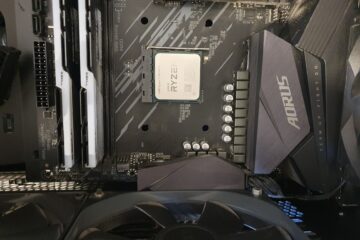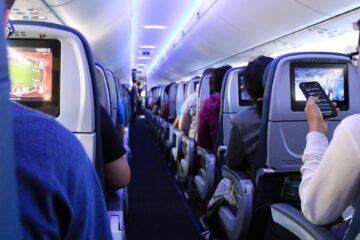After you have decided, which kind of software to use, let’s now take a look at the computer hardware and peripherals you are going to need in your project! First of all, here’s an overview of the components that I recommend you when you are right starting up:
PCs:
- One powerful PC for your FSX/P3D System
- One normal PC for your FMGS-System
Monitors:
- 17″ widescreen for the MIP Captain-Side
- 17″ widescreen for the MIP First Officer-Side (at the beginning optional, later essential)
- 19″ 4:3 screen for the MIP E/WD and SD as well as the Standby-Instruments
-
A Monitor of your choice that displays the outer view, the Software-MCDU and the Software-Overhead-Panel. I am using an old 23″ widescreen for this. If you already have a Beamer, you can use it therefore of course.
-
If you have cheap access to Monitors, an additional 23″ widescreen is helpful to display the Overhead-Panel and the MCDU, so you don’t always need to switch between the outer view and the MCDU/Overhead. One more 23″ Monitor can greatly enhance your flight experience, if you’re adding it to the outer view. But don’t spend too much money on this, as you will only need those monitors as long as your home cockpit is not flyable. Afterwards all the 23″ monitors in this example will be obsolete.
Periphals
- Common Joystick, like the Logitech Attack 3
- Logitech G Saitek PRO Flight Throttle Quadrant, which can be easily modified to an Airbus-like Throttle with detents and thrust levers.
- Logitech G Saitek PRO Flight Rudder Pedals
- 1 GBit/s Network Switch, to connect your PCs over the Network. I am using the Netgear GS105/GS108. They are very reliable and have a robust and fanless design.
- High-Quality USB 2.0 Hub, as you will shortly run out of USB-Ports. I recommend to use EXSYS-Products like the EX-1178 as they are using high-quality USB-Chipsets
- Stereo Loudspeaker-System to hear at least the Callouts and Warning-Sounds and for the Engine noise of course 🙂
- Mouse and Keyboard for every PC
What you should know about Hardware Requirements
The hardware requirements for your home cockpit are primarily driven by the fact, that Flight Simulation Software in general is highly performance-intensive. This basically applies to FSX as well as to P3D. When you are finally running two or three displays or beamers with Full-HD resolution, every frame per second (fps) counts!
This behaviour is important to understand: For the outer view you will need at least two Full-HD displays/beamers. This means you are going to run a total resolution of 3840×1080! With two displays, you can cover a view angle of about 155°. If you want to cover a full 180° view (including the side windows), you’ll need three displays/beamers, resulting in a resolution of 5760×1080. If you’re a reader of computer blogs or magazines, you may know that the best current graphics cards are able to run games at 4K-resolution with around 60 fps. The target of your home cockpit system should be to run stable at 30 fps, which is a tough challenge, even for the latest hardware.
The main limiting factors are, that FSX/P3D is not able to use more than only one single-core of your CPU and that even the best current graphics cards can only hardly cover highest detail settings at highest resolutions. This is the main battle that you will fight with your home cockpit hardware. You’ll need to find the suitable detail settings that match with your hardware performance and with some compromise, you’ll be able to achieve a quite good system performance.
So what are the options?
As you see, it’s essential to take actions to optimize the performance of your system. One effective measure is, to divide the load to several computers, which is an absolutely common strategy. I haven’t seen any home cockpit in final state, that consists of less than at least three computers. I do clearly not recommend to start up with a single system. The performance will be so bad, that you will be quickly frustrated and that’s what we don’t want. Stick to my advice as mentioned above and start up with two PCs.
I will now give you a quick statement and a recommendation on every important hardware component as follows:
CPU
As FSX/P3D is limited to use only one single-core of your CPU, achieving a high CPU clock should be your primary concern. Best practise is to use an Intel Core i5/i7 CPU with K-Specification (the K stands for overclocking-friendly), as even the older Intel CPUs’ performance is superior to AMDs current Ryzen Generation, if you are focussing on Single-Core-Performance. The Intel CPUs are also easy to overclock, so you can gain up to 25% additional performance. Depending on your budget, you can choose between the latest Intel Core i5/i7 Coffee Lake Generation or an older Sandy Bridge i5-2500k for example, like I’m using. My i5-2500k is running stable at 4.3 GHz with a maximum heat of 62°C. (Normal clock is 3.3 to 3.7 GHz).
Current Intel i7 CPUs can reach more than 5 GHz when overclocked carefully and for sure, current CPUs have a noticeable performance advantage if compared to older generations. As against the Sandy Bridge Generation, the performance of the current Coffee Lake Generation is about 25% higher, so the combination of current hardware and overclocking can get you a very high performance!
CPU-Cooler
Don’t forget this important component and don’t save money on it! The CPU of your FSX/P3D-System will be exposed to very high load over hours and hours and this means high temperatures, especially when it comes to overclocking. So it makes a lot of sense to buy a powerful CPU-Cooler. Expect minimum-costs of at least 50 Euros for a recommendable air-based cooler. Liquid/water coolers are available from 130 Euros. The higher your ambitions on overclocking are, the better your cooling system should be!
Don’t forget that it makes sense to have a good venting inside your computer-case, too. The heat that your components generate, needs to be moved out of your case. 120/140 mm case vents can prevent your system from heat accumulation.
Motherboard
I highly recommend to use a high quality Motherboard, which is also recommended for overclocking. It has to fit according to your CPU-type and it should be able to carry at least 16 GB of RAM. More than 16 GB capacity make sense, to be future proof with P3D. Please consider to buy a board with some more PCIe-Slots, as you might need them later for several sound or other expansion-cards.
Main-Memory (RAM)
To make it short: FSX doesn’t take any advantage from a lot of RAM, while P3D Version 4 or higher does, because it is 64-bit capable. Therefore Lockheed Martin recommends 16 GB RAM for P3D. I would suggest to take 24 GB or even 32 GB, if you are planning a new system and if you can afford. In any case, you shouldn’t have less than 8 GB of RAM in your FSX/P3D System as your operating system and many other applications will definitely need it.
Hint: Please don’t waste your money on main memory with extra small latency timings. The advantage will only be measurable in benchmarks. In my opinion, they have zero impact on your flight simulation performance.
Graphics Card
Regarding your graphics card, it makes absolutely sense to get a powerful one. Especially when you are using P3D, this is a must! P3D is delegating much load to the GPU and it uses state of the art graphics standards (DirectX, OpenGL) that require a powerful graphics card. If you can’t afford a NVidia GTX 1070 or better, start small and upgrade later. You can turn down your detail settings until you have a better graphics card.
The next generation of Nvidia graphic cards (Volta) is expected to deliver up to 30% extra performance on the best cards of the current Nvidia Pascal-Series (GTX 1080 Ti). I would recommend to wait for it and see how the performance will be. With the release of the new generation, Pascal-Series cards will become much cheaper and attractive on the secondhand market. The first Volta-Cards are expected to be released in 2018.
One word to FSX. As mentioned earlier, because of older graphic standards FSX doesn’t have that high requirements on graphics performance as P3D, so I’m currently using a seconhand GTX 680 – for FSX with two HD-displays/beamers it’s sufficient.
Hard-Disk
No matter whether you’re buying a new PC or not – a Solid State Drive (SSD) is worth every penny. SSDs have a much better read/write rate than conventional HDDs and your Flight Simulator will thank you by giving you much shorter loading times. When buying one, check if your Motherboard supports M2-SSDs. This is the latest standard with excellent performance.
If your budget allows it, you can install two SSDs, for example to have a separate disk only for your Flight Simulation Software. But in such case, I would rather recommend to set up a RAID1 (Mirroring) from two SSDs, as reliability becomes very important over time.
Power Supply
I don’t see any important features that a power supply of good qualitiy should have, except that it’s power should match your systems power requirements. You don’t need to buy a silent-version, as you won’t hear your PC anyway whilst taking off 🙂 In most cases, a common power supply will do the job. If you have a very powerful system, it should deliver 450 to 500 Watts. Verify if the power supply provides enough power connectors, e.g. for your graphics card. They sometimes need extra power via special adapters. (For example 4 to 6pin).
Note: The further plan is, to install FSX/P3D on your powerful computer and most of the FMGS-Applications on the other computer (except the FMGS-Server Module, which needs to run on the FSX/P3D PC.) I will guide you through the setup of Jeehell FMGS in a future post.
As I mentioned above, it is absolutely not unusual to have three or even more PCs in the final state of your home cockpit. But your second or third PC doesn’t need to be a high performance system. Even an older system with a normal HDD is sufficient in most cases. To verify the performance, monitor the systems cpu-load in the Task-Manager while you are running your FMGS-Applications during Flight. The load should not exceed more than 70% and the applications should run smoothly.



0 Comments